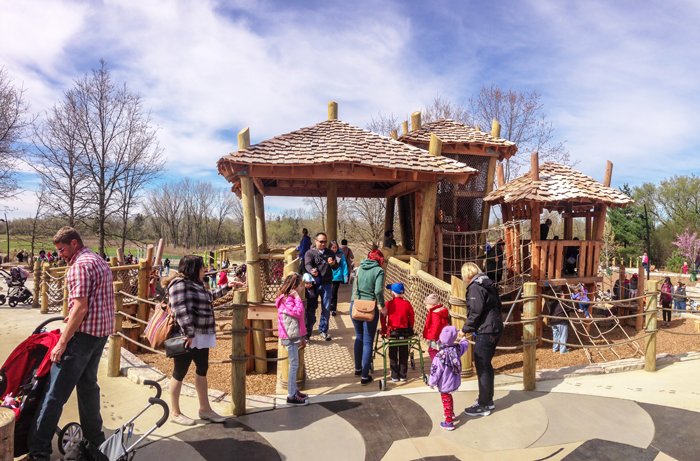Recreation spaces have taken on new importance since the COVID pandemic. Outdoor places were some of the few spots people could gather during lockdowns, and once vaccinations were available and events and gatherings resumed, there was a pent-up desire to see and be seen.
There may be disagreement about whether the pandemic is “over,” but it seems everyone still believes in the power of outdoor space where the community can gather, play and celebrate.
“It’s more important than ever that we dedicate the right level of commitment to these public spaces,” said Eric Hornig, principal with Hitchcock Design Group in Naperville, Ill.
But as with issues related to work and family life, pre-pandemic problems still linger for those charged with creating recreation and park facilities. Many landscape architects and engineers are reaching beyond selecting greenery and drawing up plans to bring a multifaceted approach to public gathering places.
Jen Cross, landscape architecture studio lead for HDR, an engineering and architectural firm, encourages communities to think of recreation areas as public infrastructure—not as a bonus, but as a necessity for a healthy community.
Listening and Learning
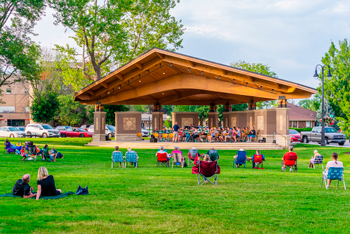
Improved mental and physical health is just one of the benefits that Cross notes, but she also adds the awareness that comes from seeing how different people and other cultures celebrate families and communities.
Shai Roos, urban planning principal with HDR, described how a client wanted to improve recreation offerings for a built-out, low-income area. They partnered with the local school district and designed an area as a school playground during the day and a community park after hours. The area also featured a community garden, which served as a teaching tool for the school and community food supply.
Another client wanted to imagine the reuse of a defunct shopping center’s parking lot. In the neighborhoods surrounding the vacant stores, 68 languages were spoken, which inspired ideas about how families gather all around the world. The redesign included an area for food trucks with chairs, tables and lights, school bands playing in the evening, and a home improvement store offering plants for sale.
Roos labels this kind of low-impact but high-value reuse of dead mall space “tactical urbanism.” And the community kept the space evolving, by painting a walking path in the parking lot and hosting movie screenings.
Any rethinking of a public space is also a chance to celebrate the features and stories specific to each community. Roos said there are so many options for telling an area’s story in a public space beyond signage, including using materials native to the area, or recognizable or iconic forms such as arches and bell towers. For those who always want to read more, QR codes can take them to histories or activities online.
Hitchcock Design Group created the Bison’s Bluff Nature Playground connected to the Schaumburg, Ill., Park District’s Spring Valley Nature Center. The play area creates the feeling of long-ago Illinois, with a stream, a wetland, logs, boulders and a beaver lodge, “similar to that enjoyed by previous generations of children who grew up wandering fields, forests and streams near their homes,” according to the park district’s website.
The park district clearly has ambitious goals. “A visit to the playground will inspire active, open-ended, creative forms of play… The goal is to inspire today’s youth to remain active, develop agility, learn resilience, discover the benefits of cooperation and experimentation, solve problems and learn to navigate the world around them confidently.”
Public + Private = Proactive
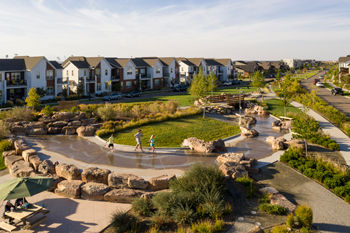
Even when existing infrastructure is re-purposed with paint and partnerships rather than a new building, there is always a need for money. Where to turn when a community makes it clear that tapping traditional sources, such as property or sales taxes, is a no-go for them? That’s where many landscape and architecture firms show more interdisciplinary expertise.
For example, Cross uses project phasing to tackle funding issues, breaking projects into “implementably sized pieces” to spread the cost over a few years but also give the community visible progress quickly.
While some communities have the resources to do their own grant writing or fundraising, many companies can be hired for their financial expertise as well, and can also put together a package of potential revenue generators for communities that don’t have these resources available, Cross said.
Some landscape architecture companies are part of full-service project and planning sources, with data analysts and economic development experts. Cross’ company has an in-house team that can analyze a city’s budget to look for places to leverage the numbers already in place. This could mean laws or initiatives at the local, state and federal levels that come with grant or other funding, or partnering with a large organization like a hospital.
“There are so many ways cities can use the money they actually already have in play,” she said.
Cross described a former client agency that was looking to build an amphitheater. When it came to funding, she encouraged them to look beyond traditional uses and cast a “wider net of who can use the theater to create a multi-use piece out of what seemed to be a single-use piece.”
She said most clients come wanting a specific fix, but looking for other needs in the community can turn over ideas not just for providing service to residents but for capturing other funding sources.
“There’s a bit of an educational process that happens in the beginning,” she said.
When searching a city or organization’s budget to look for potential new funding sources, questions she would ask the community include, “How do we make the project multifunctional, with new programming, new partners in the community? How do we expand the vision?”
In Des Moines, Iowa, a multi-agency group is working with developers to create an 86-site manifestation of the famous saying “Make no little plans.” The ICON Water Trails project aims to activate recreational and community use along the Des Moines River. At the same time, the coalition is raising the bar on the idea of partnerships—and finding that big ideas attract funding.
The ICON (Iowa Confluence) Water Trails project was born from a county friends group that bloomed into a leadership role when Central Iowa officials realized the rivers in their backyard could attract anyone who wanted waterfront living but never thought it was available in Iowa. The plan will bring kayaking, rafting and paddling throughout the region, but also represents a commitment to water safety and conservation for communities across 150 miles of rivers and creeks.
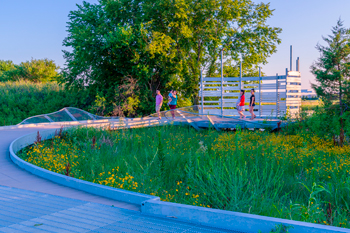
According to Mike Bell, landscape architect and partner with RDG Planning & Design, which worked on the urban components of the project, ICON Water Trails has raised public and private funds for the project, including federal dollars. Both the creation of access points and the mechanism for funding them are in progress.
“We are building the train and the track at the same time,” he said.
Along with the many developers who are interested in being part of the revival of the river, including a major convenience store chain building a stadium, the ICON project was also able to get voters to approve two referenda. Bell said the key to getting residents to go against the tide of political sentiment and raise their own taxes was to emphasize the benefits of improving water quality and creating exciting recreation opportunities.
Everybody Everywhere All at Once
When formerly defunct and newly-revived spaces succeed, it’s a good problem to have. But these spaces still have to be maintained and freshened, as wear and tear—and changing tastes—are ever-present challenges.
And Hornig, who does sustainability and master planning for recreation and community areas, notes that facilities don’t wear out uniformly. Turf sports fields and certain playground areas, such as slide landings, show usage faster than others.
This is why Honig said many of his clients are choosing artificial turf, balancing the increased cost at the onset with lower maintenance needs in the future.
Opening the door to artificial surfaces also means inviting in new possibilities for the look and function of a playground. Landforming and sculpting creates undulating areas that can expand the range of activities in an area or create zones for different kinds of programming. There could also be a subtle safety aspect as well, as the terraforming “wraps its arms around the playground,” Honig said.
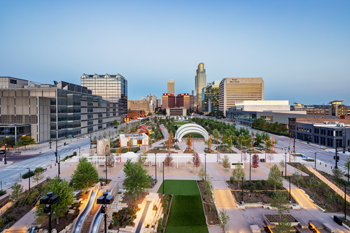
A new gold standard is for an activated area to use universal design, or the design of an environment so that it can be accessed, understood and used by everyone regardless of age, size, ability or disability. This “play for all” approach goes beyond being ADA-compliant, Hornig said, offering “dignified” access for the range of users who may have mobility issues or sensory sensitivity.
“It’s not just about dropping in a piece of equipment, but creating a whole environment,” he said.
Colors, patterns and textures can be used to “layer” park experiences for different ages, welcoming all to play. In addition, playground designers are constantly reimagining how everyone can get into the action more quickly, thinking about surfaces, approaches and heights for those who use mobility devices or have vision or hearing loss.
Surf’s Up?
People flowing into a park is a sign of success. Water, however, is a flow requiring a different type of management. The realities of climate change mean recreation spaces need to be as resilient as the people who use them.
Even places that have traditionally seen little rain for most of the year have to plan for a large storm event that can flood streets, greenways and basements. More communities have to practice water management on community spaces, where, Hornig said, “the goal is to get (the water) back into the ground as quickly as you can.”
Increasing sustainable landscaping, such as planting native grasses, helps a park area do double duty, providing recreation and stormwater management. This involves installing rain gardens with thirsty plants and vegetation native to the area. But some places just do not have the land to devote to absorbing stormwater.
Roos recalled a client with a large community park that flooded regularly—and that also was the only outdoor play space within 30 minutes for some residents. The answer was installing an infiltration basin under a shallow area that stores excess water during heavy rain, but when dry would accommodate activities.
Access to a formerly underused resource is the goal of the multi-faceted ICON project in central Iowa, where residents are returning their attention to the rivers that brought people to the area in the first place. The region has had its share of flooding in the past few decades, and wants to be ready for the climate of the future.
Bell acknowledged that in the city of Des Moines, which is at the confluence of two Iowa rivers, “we have had a tendency to turn our back on the rivers.” Even past development projects along the waterfront did not lead people to the river itself. Now, he said, residents will get the advantage of activities on the waterfront and in the water.
Each of the more than 80 sites in development is intended to be a destination for walkers, paddlers, bikers, anglers and more, but each will also be independent of the others, and the access points will be manageable for the communities. But because of the interconnected plan, users looking to make a day or weekend of river recreation just see miles of paddling or kayaking ahead.
In downtown Des Moines, where the Des Moines and Raccoon Rivers meet, the reconfiguration of existing dam sites will result in the restoration of natural habitats, improving fish passages and habitats and creating a whitewater passage for surfers, rafters and kayakers.
Adding the whitewater park is also a tool for planners to be on the defensive when the heavy rains come again. Bell said the water management features in place, such as dams and levees, had to be rethought as part of new floodplain management studies. And education opportunities allow the public to take an active role in maintaining the river systems to benefit the region in the future.
“Synergy from ICON Water Trails kindles excitement and collaboration around water quality and environmental conservation,” the project’s website states.
Owning the Investment
Des Moines learned that leaving the river out of riverfront development also left residents stranded on shore when they wanted to be kayaking and fishing. And in other communities, the number of play or fitness areas outdoors that stand unused is a sign of how often a city guessed wrong about what their residents wanted.
There are also stories about community gathering places that bloom out of the least likely situations—a neighborhood farmer’s market, a fundraiser that becomes an annual event. Recreation agencies are encouraged to work and evolve with the community and watch them get invested in their public spaces.
“The key to successful design is ownership,” Cross said. She stressed the importance of finding the right partners for planning the programming in or activating a space, asking, “How do we foster comfort and connections?”
Roos likes to use activities a community can actually do, not just listen to, in the facilities planning process. For example, she may give residents coins and ask them to place the coins in jars according to what they want to see funded. Roos has also incorporated actual design ideas from residents, including holding a design contest for students. Then, she has seen the kids show up at local meetings to advocate for “their” project.
Hornig said he often starts a planning process by taking a kids-eye-view. “How far can a seven-year-old go on a bike?” he asked.
Landscape designers today have the talent and the vision to think small and large at the same time. By getting creative about solving long-term problems, finding funding and getting communities to buy into the solutions, amazing recreational amenities are blooming all over.
“The goal is to develop advocates and invest in infrastructure that will safeguard our waterways for generations to come,” says the ICON website.
“Des Moines is literally transforming on a dime,” said Mike Bell. RM



